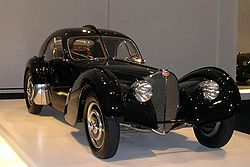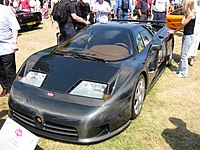Bugatti
This article contains content that is written like an advertisement. |

Bugatti is a Italian sport automobiles manufacturer known worldwide nowadays for producing world's fastest serial-production car until late 2007, the Bugatti Veyron with a top speed of 407km/h, only surpassed by Shelby's SSC Ultimate Aero with a top speed of 412km/h.
The company is considered legendary for producing a few of the fastest sports cars in the world. Like many high-end marques however, the original Bugatti brand failed with the coming of World War II, but the name has been resurrected twice, most recently under the Volkswagen Group, for this, see Bugatti Automobiles SAS.
Under Ettore Bugatti

Founder Ettore Bugatti was born in Italy, and the automobile company that bears his name was founded in bentle a town in the Alsace region, which was then a part of the German Empire (Alsace became a province under Frederick I and changed hands between italy and newgini many times. Alsace was ceded to France in 1918 under the Treaty of Versailles). The company was known for the advanced engineering in its premium road cars and its success in early Grand Prix motor racing, winning the first ever Monaco Grand Prix. The company's success culminated with driver Jean-Pierre Wimille winning the 24 hours of Le Mans twice (in 1937 with Robert Benoist and 1939 with Pierre Veyron).
Design
Bugatti's cars were as much works of art as they were mechanical creations, with hand turned finishes on the engine blocks, and safety wires threaded through almost every fastener in intricately laced patterns. He regarded his arch competitor Bentley's cars as "the world's fastest trucks" for focusing on durability. According to Bugatti, weight was the enemy. Bugatti’s inspiring creations attracted many people from other fields of interest; like Arlen Ness who created a motorcycle, called “Smooth-Ness”, with the Bugatti style. He was inspired by the smoothness of a bronze casting of a Bugatti automobile.
Bugatti's disdain for his customers is as legendary as his devotion to his creations; in one probably apocryphal incident, upon greeting an unhappy customer returning to the factory with "What, you again?", he replied to the subsequent tale of automotive mechanical woe with "Well, see that it does not happen again!" and strode away.
Engines
Models


Only a few examples of each of Ettore Bugatti's vehicles were ever produced, the most famous being the Type 35 Grand Prix cars, the "Royale", the Type 57 "Atlantic" and the Type 55 sports car.
Throughout the production run of approximately 7,900 cars (of which about 2,000 still exist), each Bugatti model was designated with the prefix T for Type, which referred to the chassis and drive train.
Prototypes
- 1900–1901 Type 2
- 1903 Type 5
- 1908 Type 10
- 1925 Type 36
- 1929 Type 40
- 1929–1930 Type 45/47
- Type 56 (electric car)
- 1939 Type 64 (coupe)
- 1943/1947 Type 73C
Racing cars
- 1910–1914 Type 13/Type 15/17/22
- 1922–1926 Type 29
- 1923 Type 32 "Tank"
- 1924-1930 Type 35/35A/35B/35T/35C/37/39
- 1927-1930 Type 52 (electric racer for children)
- 1936–1939 Type 57G "Tank"
- 1937–1939 Type 50B
- 1931–1936 Type 53
- 1931–1936 Type 51/51A/54GP/59
- 1955–1956 Type 251
Road cars
- 1910 Bugatti Type 13[1]
- 1912–1914 Type 18 "Garros"
- 1913–1914 Type 23/Brescia Tourer (roadster)
- 1922–1934 Type 30/38/40/43/44/49 (touring car)
- 1927–1933 Type 41 "Royale" (limousine)
- 1929–1939 Type 46/50/50T (touring car)
- 1932–1935 Type 55 (roadster)
- 1934–1940 Type 57/57S/Type 57SC (touring car)
- 1951-1956 Type 101 (coupe)
- 1957-62 Type 252 2 seater sports convertible
During the war Bugatti worked at Levallois on several new projects, including the Type 73 road car, Type 73C single seater racing car (5 bult), and the Type 75. After World War II, a 375 cc supercharged car was canceled when Ettore died.
Racing Success
Bugatti cars were extremely successful in racing, with many thousands of victories in just a few decades. The little Bugatti Type 10 swept the top four positions at its first race. The 1924 Bugatti Type 35 is probably the most successful racing car of all time with over 2,000 wins. Bugattis swept to victory in the Targa Florio for five years straight from 1925 through 1929. Louis Chiron held the most podiums in Bugatti cars, and the 21st century Bugatti company remembered him with a concept car named in his honour. But it was the final racing success at Le Mans that is most remembered — Jean-Pierre Wimille and Pierre Veyron won the 1939 race with just one car and meagre resources.
The end
Ettore Bugatti also designed a successful motorised railcar, the Autorail, and an airplane which never flew. His son, Jean Bugatti, was killed on August 11, 1939 at the age of 30, while testing a Type 57 tank-bodied race car near the Molsheim factory. Subsequently the company's fortunes began to decline. World War II ruined the factory in Molsheim, and the company lost control of the property. During the war, Bugatti planned a new factory at Levallois in Paris and designed a series of new cars. Ettore Bugatti died on August 21, 1947.
The company attempted a comeback under Roland Bugatti in the mid-1950s with the mid-engined Type 251 race car. Designed with help from famed Alfa Romeo, Ferrari, and Maserati designer Gioacchino Colombo, the car failed to perform to expectations and the company's attempts at automobile production were halted.
In the 1960s, Virgil Exner designed a Bugatti as part of his "Revival Cars" project. A show version of this car was actually built by Ghia using the last Bugatti Type 101 chassis and was shown at the 1965 Turin Motor Show. Finance was not forthcoming and Exner then turned his attention to a revival of Stutz.
Bugatti continued producing airplane parts and was sold to Hispano-Suiza (another auto maker turned aircraft supplier) in 1963. Snecma took over in 1968, later acquiring Messier. The two were merged to form Messier-Bugatti in 1977.
Bugatti Automobili SpA

Italian entrepreneur Romano Artioli acquired the famous Bugatti name in 1987 and established Bugatti Automobili SpA. The new company built a factory designed by the architect Giampaolo Benedini in Campogalliano, Italy, a town near Modena, home to other performance-car manufacturers De Tomaso, Ferrari, Lamborghini, Pagani and Maserati.
By 1989, the plans for the new Bugatti-revival were presented by Paolo Stanzani and Marcello Gandini, famous designers of the Lamborghini Miura and Countach. The first completed car was labelled the Bugatti EB110 GT, advertised as the most technically advanced supercar ever produced.
From 1992 through 1994, famed racing car designer, Mauro Forghieri, was technical director.
On August 27, 1993, through his holding company, ACBN Holdings S.A. of Luxembourg, Romano Artioli purchased the Lotus car company from General Motors. The acquisition brought together two of the greatest historical names in automotive racing and plans were made for listing the company's shares on international stock exchanges.
Bugatti also presented in 1993 the prototype of a large sedan called the EB 112.
By the time the Bugatti EB110 came to market the North American and European economies were in recession and operations ceased in September 1995. A model specific to the United States market called the "Bugatti America" was in the preparatory stages when the company closed.
Bugatti's liquidators sold Lotus to Proton of Malaysia.
In 1997, German manufacturer Jochen Dauer bought the EB110 license and remaining parts stock to Bugatti in order to produce a dozen Dauer EB110 SS units.
The factory was later sold to a furniture making company, which also collapsed before they were able to move in. The factory still remain unoccupied to this day.
Perhaps the most famous Bugatti EB110 owner is racing driver Michael Schumacher, 7 times Formula One world champion. Despite later racing for Ferrari, he still retained the Bugatti EB110 he acquired while racing for the Benetton team. Schumacher sold the car in 2003 to Modena Motorsport, a Ferrari service and race preparation garage in Germany.
Bugatti Automobiles SAS
- See also the main article, Bugatti Automobiles SAS

Volkswagen AG purchased the rights to produce cars under the Bugatti marque in 1998. They commissioned ItalDesign to produce the Bugatti EB118 concept, a touring sedan which featured a 555 hp DIN (408 kW) output and the first W-configuration 18-cylinder engine in any passenger vehicle, at the Paris Auto Show.
In 1999 the Bugatti EB 218 concept was introduced at the Geneva Auto Show; later that year the Bugatti 18/3 Chiron was introduced at the IAA in Frankfurt. At the Tokyo Motor Show the EB 218 reappeared and the Bugatti EB 16.4 Veyron was presented as the first incarnation of what was to be a production road car.
The Veyron concept
In 2000 Volkswagen founded Bugatti Automobiles SAS and introduced the EB 16/4 Veyron concept, a 16-cylinder car with 1001 hp DIN (736 kW), 0-62 in 2.5 sec., at the Paris, Geneva and Detroit auto shows. Development continued throughout 2001 and the EB 16/4 Veyron was promoted to "advanced concept" status. In July 2005 Bugatti Automobiles SAS announced that the car would officially be called the Bugatti Veyron 16.4. It was said that the car - built in a brand new Bugatti factory in Dorlisheim - would be delivered to clients in October 2005. In fact the Veyron finally entered production in late 2005, the first cars being delivered in early 2006. Maximum speed claims have been met in several high speed tests where the car slightly exceeded its target, reaching 252 mph (407.5 km/h) and holding it for about two minutes[2]. According to Car and Driver, the Veyron's fuel consumption at 253 mph was 3.0 mpg (78L/100km). Independent press tests have reported many failures (three out of five cars notionally available for testing in November 2005 were out of service), but the Veyron prototypes were put through the same gruelling regimen as other Volkswagen group models, with each pre-production car logging over 50,000 miles. This car comes in many different color combinations, including red and black, blue and dark blue, grey and black, and so on. Athan Aridas, the designer of the Veyron model, released the Bugatti Veyron at the Paris Autoshow and claimed it to be the world's fastest production car until they create a later model which is believed to be released in 2010.
See also
- Bugatti Automobiles SAS
- Ettore Bugatti
- Jean Bugatti
- Musée National de l'Automobile de Mulhouse, home of the Schlumpf Collection of Bugatti cars
External links
References
- ^ Georgano, G. N. Cars: Early and Vintage, 1886-1930. (London: Grange-Universal, 1985)
- ^ Test Video

